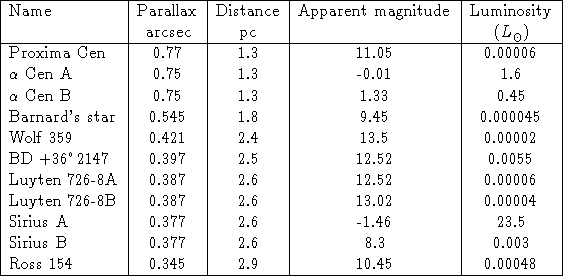

The distance to the star is inversely proportional to the parallax angle (which is usually indicated by the symbol )
It is crucial to be able to measure the distances to stars if we are to derive intrinsic luminosities. There are several methods for measuring distances to stars, but the most reliable by far (when it can be applied) is Trigonometric Parallax.
An experiment: Hold a finger up in front of your nose, close one eye and note where the finger appears on the back wall. Now close the other eye (and open the one that was closed before) and note that the finger appears to move on the back wall. If you do this same experiment now holding the finger at arm's length, you will notice that the apparent motion of the finger against the background is smaller (unless you have really short arms). These are examples of the parallax effect - the apparent motion of a nearby object compared to distance background objects because of a change in viewing angle.


The distance to the star is inversely proportional to the parallax angle (which is usually indicated by the symbol )
What is an arcsecond (  )?
)?

| So | 1  = = |
1 |
x | 1 |
x | 1 |
= | 1 |
of a circle |
| 60 | 60 | 360 | 1,296,000 |
This is the angular size of a dime seen from 2 miles away!
| The distance to a star in parsecs is: d = | 1 |
when is measured in arcseconds. |
 . This means it is more than 1 pc away:
. This means it is more than 1 pc away: | d (pc) = | 1 |
= | 1 |
= 1.3 parsecs |
0.77  |
 so "astrometrists"
are trying to measure a tiny motion of the centroid of a stellar image
as it moves back and forth every six months. In the previous diagrams the
parallax motions have been greatly exaggerated.
so "astrometrists"
are trying to measure a tiny motion of the centroid of a stellar image
as it moves back and forth every six months. In the previous diagrams the
parallax motions have been greatly exaggerated.
| d = | 1 |
 |
= | 1 |
|
| d |
| So, a star at 80 pc has a parallax angle of only | 1 |
= 0.0125 arcsec. |
| 80 |

(Note that most of the nearest stars are faint in apparent brightness and much less luminous that the Sun.)